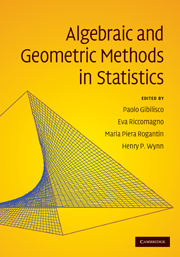Book contents
- Frontmatter
- Contents
- List of contributors
- Preface
- Frequently used notations and symbols
- 1 Algebraic and geometric methods in statistics
- Part I Contingency tables
- 2 Maximum likelihood estimation in latent class models for contingency table data
- 3 Algebraic geometry of 2×2 contingency tables
- 4 Model selection for contingency tables with algebraic statistics
- 5 Markov chains, quotient ideals and connectivity with positive margins
- 6 Algebraic modelling of category distinguishability
- 7 The algebraic complexity of maximum likelihood estimation for bivariate missing data
- 8 The generalised shuttle algorithm
- Part II Designed experiments
- Part III Information geometry
- Part IV Information geometry and algebraic statistics
- Part V On-line supplements
6 - Algebraic modelling of category distinguishability
from Part I - Contingency tables
Published online by Cambridge University Press: 27 May 2010
- Frontmatter
- Contents
- List of contributors
- Preface
- Frequently used notations and symbols
- 1 Algebraic and geometric methods in statistics
- Part I Contingency tables
- 2 Maximum likelihood estimation in latent class models for contingency table data
- 3 Algebraic geometry of 2×2 contingency tables
- 4 Model selection for contingency tables with algebraic statistics
- 5 Markov chains, quotient ideals and connectivity with positive margins
- 6 Algebraic modelling of category distinguishability
- 7 The algebraic complexity of maximum likelihood estimation for bivariate missing data
- 8 The generalised shuttle algorithm
- Part II Designed experiments
- Part III Information geometry
- Part IV Information geometry and algebraic statistics
- Part V On-line supplements
Summary
Abstract
Algebraic Statistics techniques are used to define a new class of probability models which encode the notion of category distinguishability and refine the existing approaches. We study such models both from a geometric and statistical point of view. In particular, we provide an effective characterisation of the sufficient statistic.
Introduction
In this work we focus on a problem coming from rater agreement studies. We consider two independent raters. They classify n subjects using the same ordinal scale with I categories. The data are organised in a square contingency table which summarises the classifications. The cell (i, j) contains the number of items classified i by the first observer and j by the second observer.
Many applications deal with ordinal scales whose categories are partly subjective. In most cases, the ordinal scale is the discretisation of an underlying quantity continuous in nature. Classical examples in the field of medical applications are the classification of a disease in different grades through the reading of diagnostic images or the classification of the grade of a psychiatric disease based on the observation of some behavioural traits of the patients. An example of such problem is presented in detail in (Garrett-Mayer et al. 2004) and it is based on data about pancreatic neoplasia. Other relevant applications are, for instance, in lexical investigations, see e.g. (Bruce and Wiebe 1998) and (Bruce and Wiebe 1999). In their papers, category distinguishability is used as a tool to study when the definitions of the different meanings of a word in a dictionary can be considered as unambiguous. Table 6.1 presents a numerical example from (Agresti 1988).
- Type
- Chapter
- Information
- Algebraic and Geometric Methods in Statistics , pp. 111 - 122Publisher: Cambridge University PressPrint publication year: 2009
- 2
- Cited by



